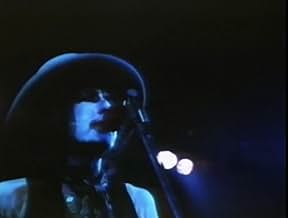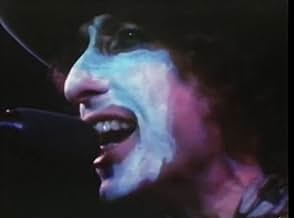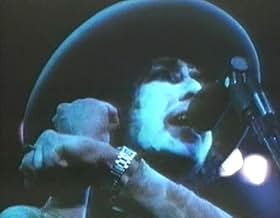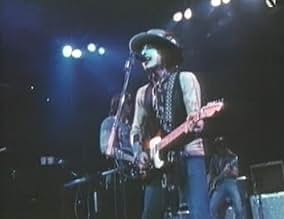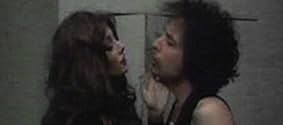अपनी भाषा में प्लॉट जोड़ेंBob Dylan on tour with the Rolling Thunder Revue in 1975; concert footage, documentary interviews and bizarre improvised character scenes.Bob Dylan on tour with the Rolling Thunder Revue in 1975; concert footage, documentary interviews and bizarre improvised character scenes.Bob Dylan on tour with the Rolling Thunder Revue in 1975; concert footage, documentary interviews and bizarre improvised character scenes.
- पुरस्कार
- कुल 2 जीत
Ramblin' Jack Elliott
- Longheno de Castro
- (as Jack Elliott)
Ruth Tyrangel
- The Girlfriend
- (as Ruth Tyrangiel)
J. Stephen Soles
- Ramon
- (as Steven Soles)
फ़ीचर्ड समीक्षाएं
Bob Dylan has never made it as an actor. Nothing proves this better than his role as Billy Parker in "Hearts of Fire" (1987). Even his minor role as "Alias" in Sam Peckinpah's "Pat Garrett and Billy the Kid" (1973) was lackluster. The song he wrote for the film, "Knockin' On Heaven's Door," however, has survived as an anthem.
But "Renaldo & Clara" is a very different sort of film. It runs nearly 4 hours and chronicles a concert tour, "The Rolling Thunder Revue." It is filled with interesting people, good music and impromptu dialogue. Even with so much situational dialogue, Dylan shared writing credits with the distinguished playwright Sam Shepard. Perhaps the thing that makes it such a valuable cinematic document is that it bridges the gap in American cultural history between the "Beat Generation" and the emerging post-modern movement.
Critics panned the film at the time of its release, probably because they did not understand that were standing at the convergence of two great social tides. What they saw as an overly long movie without the benefit of tight plotting was really the melding of "beat" stream-of-consciousness and Dylan's own unique post-modern artistic sensibilities. Critics could only compare it to some lengthy epic from India because they had no other frame of reference at the time.
In the film, the troupe re-enacts an old "true-life love triangle" (Joan Baez and Sara Dylan) and, with Allen Ginsberg, pays homage at the grave of Jack Kerouac. There are visits with Rueben "Hurricane" Carter in his jail cell and off-stage antics. It has many whimsical moments, plenty of hard-driving rock and roll and yes, it veers off the track on several occasions, but even those moments are not without their poetry.
Dylan himself takes directorial credit, and while he was surely the man in control of his vision, one must look to the person credited as Assistant Director for the more mundane aspects. This man was Jacques Levy, a former New York City psychologist who had dabbled on Broadway and whose only other screen directorial credit up to that time was for "Oh! Calcutta!" (1972), the nostalgic strip show. Peter McGuinn of the Byrds introduced Dylan and Levy in 1969. Interestingly, Levy and Dylan co-wrote all but two of the songs on Dylan's 1976 album "Desire," including "Hurricane," "Isis," "Joey," "Romance in Durango" and others which appear on the film soundtrack. Levy now teaches theater at Colgate University.
However, at the time the film was made, Levy probably could not be considered to have mastery as a director. Nor could claims of mastery be made by cinematographer and film editor Howard Alk, whose career peaked with this film. The producer was Mel Howard, and his only other credit as a producer at the time was "Quackser Fortune Has a Cousin in the Bronx" (1970). The point to mentioning all this is that Dylan was not surrounded by an over-abundance of talent when he made the film, other than the performers with him on the screen. It is testimony to Dylan's own talent that his vision was realized to any degree.
It is said that Dylan was unhappy with D.A. Pennebaker's documentary of his 1965 UK tour, "Dont Look Back," (also featuring Baez, and even Allen Ginsberg in the background of the famous "Subterranean Homesick Blues" que card scene) because he didn't get a cut of the financial action. Yet, "Renaldo and Clara" owes something to Pennebaker's work. It has the same freshness, style and spontaneity, though it is darker and more original.
"Renaldo and Clara" is a complex film. It's a concert tour film, a love story, a dues-paying to artistic influences. But simply because it is long and complex does not mean it is without its many joys. If Fellini had signed his name to this cinematic work of art, it might have been considered a masterpiece.
But "Renaldo & Clara" is a very different sort of film. It runs nearly 4 hours and chronicles a concert tour, "The Rolling Thunder Revue." It is filled with interesting people, good music and impromptu dialogue. Even with so much situational dialogue, Dylan shared writing credits with the distinguished playwright Sam Shepard. Perhaps the thing that makes it such a valuable cinematic document is that it bridges the gap in American cultural history between the "Beat Generation" and the emerging post-modern movement.
Critics panned the film at the time of its release, probably because they did not understand that were standing at the convergence of two great social tides. What they saw as an overly long movie without the benefit of tight plotting was really the melding of "beat" stream-of-consciousness and Dylan's own unique post-modern artistic sensibilities. Critics could only compare it to some lengthy epic from India because they had no other frame of reference at the time.
In the film, the troupe re-enacts an old "true-life love triangle" (Joan Baez and Sara Dylan) and, with Allen Ginsberg, pays homage at the grave of Jack Kerouac. There are visits with Rueben "Hurricane" Carter in his jail cell and off-stage antics. It has many whimsical moments, plenty of hard-driving rock and roll and yes, it veers off the track on several occasions, but even those moments are not without their poetry.
Dylan himself takes directorial credit, and while he was surely the man in control of his vision, one must look to the person credited as Assistant Director for the more mundane aspects. This man was Jacques Levy, a former New York City psychologist who had dabbled on Broadway and whose only other screen directorial credit up to that time was for "Oh! Calcutta!" (1972), the nostalgic strip show. Peter McGuinn of the Byrds introduced Dylan and Levy in 1969. Interestingly, Levy and Dylan co-wrote all but two of the songs on Dylan's 1976 album "Desire," including "Hurricane," "Isis," "Joey," "Romance in Durango" and others which appear on the film soundtrack. Levy now teaches theater at Colgate University.
However, at the time the film was made, Levy probably could not be considered to have mastery as a director. Nor could claims of mastery be made by cinematographer and film editor Howard Alk, whose career peaked with this film. The producer was Mel Howard, and his only other credit as a producer at the time was "Quackser Fortune Has a Cousin in the Bronx" (1970). The point to mentioning all this is that Dylan was not surrounded by an over-abundance of talent when he made the film, other than the performers with him on the screen. It is testimony to Dylan's own talent that his vision was realized to any degree.
It is said that Dylan was unhappy with D.A. Pennebaker's documentary of his 1965 UK tour, "Dont Look Back," (also featuring Baez, and even Allen Ginsberg in the background of the famous "Subterranean Homesick Blues" que card scene) because he didn't get a cut of the financial action. Yet, "Renaldo and Clara" owes something to Pennebaker's work. It has the same freshness, style and spontaneity, though it is darker and more original.
"Renaldo and Clara" is a complex film. It's a concert tour film, a love story, a dues-paying to artistic influences. But simply because it is long and complex does not mean it is without its many joys. If Fellini had signed his name to this cinematic work of art, it might have been considered a masterpiece.
Quirky, idiosyncratic, often confusing and much too long mixture of concert footage, documentary and fictional scenes is definitely fascinating to watch, but one wonders, if Bob Dylan ever was certain about his intentions to create this film or whether he had an idea who its potential audience would be.
The drama of Renaldo and Clara, set against Bob Dylan's Rolling Thunder Revue of 1975-76.
Part concert film, part drama, part documentary Bob Dylan's 'Renaldo and Clara' is a sprawling, disjointed, puzzling affair. The concert stuff is great, as one would expect. Dylan's Rolling Thunder Revue was a fantastic musical experience coming off the back of Dylan's excellent 'Desire' and 'Blood on the Tracks' albums and featuring Dylan at his most spontaneous, dynamic and, in terms of live performances, creative. Dylan had a great backing band (that included Mick Ronson, David Bowie's long-time guitarist) and the Revue also included big names such as Joan Baez and Roger McGuinn, performances of whose are also shown in the film.
For a Dylan fan like myself the music alone should be enough to give this film a thumbs up.
Unfortunately, it's not. The music makes around a third of this four-hour film and the remainder is very weak. The Renaldo and Clara drama is all over the place with a bare semblance of a plot and no character development or engagement.
The documentary side has some interesting bits to it: the roadies setting up the stage, some of the other background aspects to the tour, but for the most part it is like the drama, an uninteresting meander.
I really don't know what Dylan and co-writer Sam Shepard were thinking while penning the script for this or Dylan was thinking while directing and editing this. With Dylan's mountains of creativity it's not a surprise that he turned his hand to film: it's the execution that's the problem.
My one thought is that is that Dylan's songs often consist of seemingly-disjointed, stream-of-consciousness imagery and narratives and he tried to replicate that in a four-hour film. It works in a song because it's short enough that you don't need a neat, complete story, the listener can add their own interpretations and there's music so the narrative isn't all that matters. None of these mitigations apply in a feature film.
Dylan would have been far better off just releasing this as a concert film - no attempt at drama. After the full-length version bombed he did release a two-hour, mostly-concert, version of this but by then it was too late as fans had already written it off.
Part concert film, part drama, part documentary Bob Dylan's 'Renaldo and Clara' is a sprawling, disjointed, puzzling affair. The concert stuff is great, as one would expect. Dylan's Rolling Thunder Revue was a fantastic musical experience coming off the back of Dylan's excellent 'Desire' and 'Blood on the Tracks' albums and featuring Dylan at his most spontaneous, dynamic and, in terms of live performances, creative. Dylan had a great backing band (that included Mick Ronson, David Bowie's long-time guitarist) and the Revue also included big names such as Joan Baez and Roger McGuinn, performances of whose are also shown in the film.
For a Dylan fan like myself the music alone should be enough to give this film a thumbs up.
Unfortunately, it's not. The music makes around a third of this four-hour film and the remainder is very weak. The Renaldo and Clara drama is all over the place with a bare semblance of a plot and no character development or engagement.
The documentary side has some interesting bits to it: the roadies setting up the stage, some of the other background aspects to the tour, but for the most part it is like the drama, an uninteresting meander.
I really don't know what Dylan and co-writer Sam Shepard were thinking while penning the script for this or Dylan was thinking while directing and editing this. With Dylan's mountains of creativity it's not a surprise that he turned his hand to film: it's the execution that's the problem.
My one thought is that is that Dylan's songs often consist of seemingly-disjointed, stream-of-consciousness imagery and narratives and he tried to replicate that in a four-hour film. It works in a song because it's short enough that you don't need a neat, complete story, the listener can add their own interpretations and there's music so the narrative isn't all that matters. None of these mitigations apply in a feature film.
Dylan would have been far better off just releasing this as a concert film - no attempt at drama. After the full-length version bombed he did release a two-hour, mostly-concert, version of this but by then it was too late as fans had already written it off.
Renaldo And Clara was hit hard by critics, but was a true testimont that Bob Dylan (Robert Zimmerman) is the true modern leader of entertainment, and learder of social change.
P.S. I would also like to find somewhere where I can buy this movie.
P.S. I would also like to find somewhere where I can buy this movie.
The movie was filled with bad acting.
Plus, this movie did Joan Baez extremely dirty, erasing the fact that Joan Baez dated Bob Dylan in 1964. In 1965 Bob Dylan cheated on Joan Baez with Sara Lownds, then he goes & re-write history in Renaldo and Clara, turning Joan into the 'other woman' in his fairy tale marriage.
Warning: At the timestamp of 3 hours 20 minutes, Bob Dylan starts gargling. What is this? A Cofsils experdine gargle commercial?
Alternate title of the movie: This Movie is a Giant Middle Finger to Joan Baez. Dump Joan Baez, break her heart, marry the other girl named Sara Lownds, and then flip the tables and cast Joan Baez as the other girl instead. Talk about erasing the truth, eh? Plus, gargle a while to make audience confused and make people fools for 4 hours straight and pretend it to be a cinematic masterpiece".
Plus, this movie did Joan Baez extremely dirty, erasing the fact that Joan Baez dated Bob Dylan in 1964. In 1965 Bob Dylan cheated on Joan Baez with Sara Lownds, then he goes & re-write history in Renaldo and Clara, turning Joan into the 'other woman' in his fairy tale marriage.
Warning: At the timestamp of 3 hours 20 minutes, Bob Dylan starts gargling. What is this? A Cofsils experdine gargle commercial?
Alternate title of the movie: This Movie is a Giant Middle Finger to Joan Baez. Dump Joan Baez, break her heart, marry the other girl named Sara Lownds, and then flip the tables and cast Joan Baez as the other girl instead. Talk about erasing the truth, eh? Plus, gargle a while to make audience confused and make people fools for 4 hours straight and pretend it to be a cinematic masterpiece".
क्या आपको पता है
- ट्रिवियाThe film got many negative reviews, and some theaters refused to show it. Most theaters showed a two-hour cut that was mostly concert footage. The original four-hour director's cut was first shown on European television years later.
- भाव
The Truck Driver: Why are you so much in a hurry? Is the law after you?
Renaldo: I am the law!
- क्रेज़ी क्रेडिटThe opening credits end with a title card reading "A Film by BOB DYLAN" directed after he is credited as writer and director. The closing credits are divided in three sections, separated by wide time gaps, played over a different artist, soul singer Hal Frazier, performing "In The Morning", a song written by Barry Gibb.
- इसके अलावा अन्य वर्जनOriginally released at 292 minutes (yes, that's almost five hours!). After dismal box office returns, Dylan shortened the film to 122 minutes removing almost all of the narrative storyline and leaving mostly concert footage.
- कनेक्शनFeatured in Bob Dylan: Change on the Tracks (2008)
- साउंडट्रैकWhen I Paint My Masterpiece
Written and performed by Bob Dylan
टॉप पसंद
रेटिंग देने के लिए साइन-इन करें और वैयक्तिकृत सुझावों के लिए वॉचलिस्ट करें
- How long is Renaldo and Clara?Alexa द्वारा संचालित
विवरण
- चलने की अवधि3 घंटे 55 मिनट
- ध्वनि मिश्रण
- पक्ष अनुपात
- 1.85 : 1
इस पेज में योगदान दें
किसी बदलाव का सुझाव दें या अनुपलब्ध कॉन्टेंट जोड़ें

